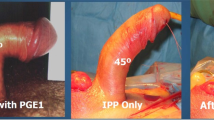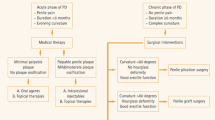Abstract
We present the use of a modified corporoplasty, based on geometrical principles, to determine the exact site for the incision in the tunica or plaque and the exact amount of albuginea for overlaying to correct with extreme precision the different types of congenital or acquired penile curvature due to Peyronie’s disease. To describe our experience with a new surgical procedure for the enhancement of penile curvature avoiding any overcorrection or undercorrection. Between March 2004 and April 2013, a total of 74 patients underwent the geometrical modified corporoplasty. All patients had congenital curvature until 90° or acquired stable penile curvature ‘less’ than 60°, that made sexual intercourse very difficult or impossible, normal erectile function, absence of hourglass or hinge effect. Preoperative testing included a physical examination, 3 photographs (frontal, dorsal and lateral) of penis during erection, a 10 mcg PGE1-induced erection and Doppler ultrasound, administration of the International Index of Erectile Function (IIEF-15) questionnaire. A follow-up with postoperative evaluation at 12 weeks, 12 and 24 months, included the same preoperative testing. Satisfaction rates were better assessed with the use of validated questionnaire such as the International Erectile Dysfunction Inventory of the Treatment Satisfaction (EDITS). Statistical analysis with Student’s t-test was performed using commercially available, personal computer software. A total of 25 patients had congenital penile curvature with a mean deviation of 46.8° (range 40–90), another 49 patients had Peyronie’s disease with a mean deviation of 58.4 (range 45–60). No major complications were reported. Postoperative correction of the curvature was achieved in all patients (100%). Neither undercorrection nor overcorrection were recorded. No significant relapse (curvature>15°) occurred in our patients. Shortening of the penis was reported by 74% but did not influence the high overall satisfaction of 92% (patients completely satisfied with their sexual life). The erectile function was analyzed in both groups, Student’s t-test showed a significant improvement in erectile function, preoperative average IIEF-15 scores were 17.43±4.67, whereas postoperatively it was 22.57±4.83 (P=0.001). This geometrical modified Nesbit corporoplasty is a valid therapy which allows penile straightening. The geometric principles make the technique reproducible in multicentre studies.
This is a preview of subscription content, access via your institution
Access options
Subscribe to this journal
Receive 8 print issues and online access
$259.00 per year
only $32.38 per issue
Buy this article
- Purchase on Springer Link
- Instant access to full article PDF
Prices may be subject to local taxes which are calculated during checkout











Similar content being viewed by others
References
Rosen R, Catania J, Lue T, Althof S, Henne J, Hellstrom W et al. Impact of Peyronie’s disease on sexual and psychological functioning: qualitative findings in patients in patients and controls. J Sex Med 2008; 5: 1997–84.
Smith JF, Walsh TJ, Conti SL, Turek P, Lue T . Risk factors for emotional and relationship problems in Peyronie’s disease. J Sex Med 2008; 5: 2179–2184.
El-Sakka AI, Hassoba HM, Chui RM, Bhatagar RS, Dahiya R, Lue TF . An animal model of Peyronie’s like condition associated with an increase of transforming growth factor beta mRNA and protein expression. J Urol 1997; 158: 2284–2290.
Larsen SM, Levine LA . Review of non surgical treatment options for Peyronie’s disease. Int J Impot Res 2012; 24: 1–10.
Langston JP, Carson CC 3rd . Peyronie’s disease: plication or grafting. Urol Clin North Am 2011; 38: 207–216.
Levine LA, Larsen SM . Surgery for Peyronie’s. Asian J Androl 2013; 15: 27–34.
Chung E, Clendinning E, Lessars L, Brock G . Five-year follow-up of Peyronie’s graft surgery: outcomes and patient satisfaction. J Sex Med 2011; 8: 594–600.
Wilson SK . Surgical techniques: modeling technique for penile curvature. J Sex Med 2007; 4: 2231–2234.
Smith JF, Walsh TJ, Lue TF . Peyronie’s disease: a critical appraisal of current diagnosis and treatment. Int J Impot Res 2008; 20: 445–459.
Kelamy A . Autophotography in evaluation of functional penis disorders. Urology 1983; 21: 628–629.
Rosen RC, Riley A, Wagner G, Osterloh IH, Kirkpatrick J, Mishra A . The international index of erectile function (IIEF): a multidimensional scale for assessment of erectile dysfunction. Urology 1997; 49: 822–830.
Rolle L, Tamagnone C, Timpano M, Destefanis P, Fiori C, Ceruti C et al. The nessbit operation for penile curvature: an easy and effective technical modification. J Urol 2005; 173: 171–173.
Montorsi F, Adaikan G, Becher E, Giuliano F, Khoury S, Lue TF et al. Summary of the recommendations on sexual dysfunctions in men. J Sex Med 2010; 7: 3572–3588.
Ralph D, Gonzalez-Cadavid N, Mirone V, Perovic S, Sohn M, Usta M et al. The management of Peyronie’s disease: Evidence-based 2010 guidelines. J Sex Med 2010; 7: 2359–2374.
Kadioglu A, Akman T, Sanli O, Gurkan L, Cakan M, Celtik M . Surgical treatment of Peyronie’s disease: a critical analysis. Eur Urol 2006; 50: 235–248.
Hauptmann A, Diemer T, Weidner W . Peyronie’s disease: diagnostics and therapy. Urologe A 2011; 50: 609–620.
Hsieh J-T, Liu S-P, Chen Y, Chang H-C, Yu H-J, Chen C-H . Correction of congenital penile curvature using modified tunical plication with absorbable sutures: the long-term outcome and patient satisfaction. Eur Urol 2007; 52: 261–266.
Poulsen J, Kirkeby HJ . Treatment of penile curvature—A retrospective study of 175 patients operated with plication of the tunica albuginea or with the Nesbit procedure. Br J Urol 1995; 75: 370–374.
Brake M, Keller H, Lamade F, Groh R, Horsch R . Surgical correction of penile deviation. Nesbit vs. Schroeder–Essed method. Urologe A 1999; 38: 264–269.
Schultheiss D, Meschi MR, Hagemann J, Truss MC, Stief CG, Jonas U . Congenital and acquired penile deviation treated with the Essed plication method. Eur Urol 2000; 38: 167–171.
Scharzer JU, Steinfatt H . Tunica albuginea underlap – a new modification of Nesbit Procedure: description of the technique and preliminary results. J Sex Med 2012; 9: 2970–2974.
Gelbard MK . Relaxing incisions in the correction of penile deformity due to Peyronie’s disease. J Urol 1995; 154: 1457–1460.
Egydio PH, Lucon AM, Arap S . A single relaxing incision to correct different types of penile curvature: surgical technique based on geometrical principles. BJU Int 2004; 94: 1147–1157.
Gur S, Limin M, Hellstrom WJ . Current status and new developments in Peyronie’s disease: medical, minimally invasive and surgical treatment options. Expert Opin Pharmacother 2011; 12: 931–944.
Cormio L, Zucchi A, Lorusso F, Selvaggio O, Fioretti F, Porena M et al. Surgical treatment of Peyronie’s disease by plaque incision and grafting with buccal mucosa. Eur Urol 2009; 55: 1469–1475.
Kuehass FE, Egydio PH . The STAGE technique (superficial tunica albuginea geometric-based excision) for the correction of biplanar congenit al penile curvature. J Sex Med 2014; 11: 299–306.
Greenfield JM, Lucas S, Levine LA . Factors affecting the loss of length associated with tunica albuginea plication for correction of penile curvature. J Urol 2006; 175: 238–241.
Author information
Authors and Affiliations
Corresponding author
Ethics declarations
Competing interests
The authors declare no conflict of interest.
Rights and permissions
About this article
Cite this article
Vicini, P., Di Nicola, S., Antonini, G. et al. Geometrical modified nesbit corporoplasty to correct different types of penile curvature: description of the surgical procedure based on geometrical principles and long-term results. Int J Impot Res 28, 209–215 (2016). https://doi.org/10.1038/ijir.2016.28
Received:
Revised:
Accepted:
Published:
Issue Date:
DOI: https://doi.org/10.1038/ijir.2016.28
This article is cited by
-
The effectiveness of penile curvature treatment by cavernous body rotation and plication of the tunica albuginea
Basic and Clinical Andrology (2023)
-
Current trends in the surgical treatment of congenital penile curvature
International Journal of Impotence Research (2020)
-
Clinical characteristics and surgical outcomes in men undergoing tunica albuginea plication for congenital penile curvature who present with worsening penile deformity
World Journal of Urology (2020)
-
Tunical Incision Techniques for Peyronie’s Disease
Current Sexual Health Reports (2017)
-
Geometry puts curvature on the straight and narrow
Nature Reviews Urology (2016)



